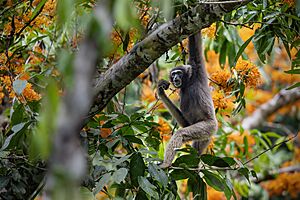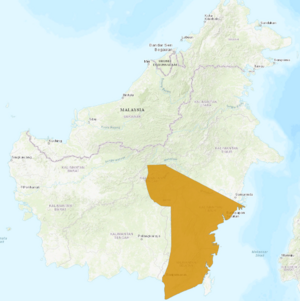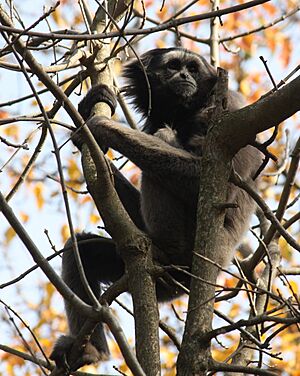Müller's gibbon facts for kids
Quick facts for kids Müller's gibbon |
|
|---|---|
 |
|
| Conservation status | |
| Scientific classification | |
| Genus: |
Hylobates
|
| Species: |
muelleri
|
 |
|
| Müller's gibbon range | |
The Müller's gibbon (Hylobates muelleri) is a type of ape. It is also known as the southern grey gibbon. These amazing animals belong to the gibbon family, called Hylobatidae. They are known for their long arms and incredible swinging abilities through the trees.
Contents
What is Taxonomy?
Taxonomy is like a big family tree for animals. It helps scientists group living things together. The Müller's gibbon was once thought to be the same species as the western grey gibbon and the eastern grey gibbon. However, newer studies show they are all different species. Important groups like the IUCN Red List and the American Society of Mammalogists now agree with this.
Physical Appearance
Müller's gibbons are special because both males and females look alike. Their fur is usually grey or brown. They have a bright ring of fur around their face. Often, they also have a dark cap of fur on their head. These gibbons are among the smaller types of gibbons. They usually weigh between 4 and 8 kilograms (about 9 to 18 pounds).
Where They Live
Müller's gibbons live only on the island of Borneo. This means they are endemic to Borneo. You can find them in the southeastern part of Kalimantan, which is the Indonesian part of Borneo. They live mostly south of the Mahakam River and east of the Barito River. Their home is the thick rainforests of this area.
Daily Life and Behavior
Southern grey gibbons are active during the day. They live in the rainforest trees. They use their very long arms to swing quickly from branch to branch. This way of moving is called brachiation.
These gibbons live in small family groups. They usually form a pair and stay together. They protect their home area from other gibbons. They do this by singing long, loud songs. Their diet is mostly made up of fruits.
Reproduction and Life Cycle
Not much is known about how Müller's gibbons have babies. However, scientists believe their reproduction is similar to other gibbon species. Other gibbons usually have one baby at a time. The baby stays with its parents for several years.
See also
 In Spanish: Gibón de Müller de Borneo para niños
In Spanish: Gibón de Müller de Borneo para niños



